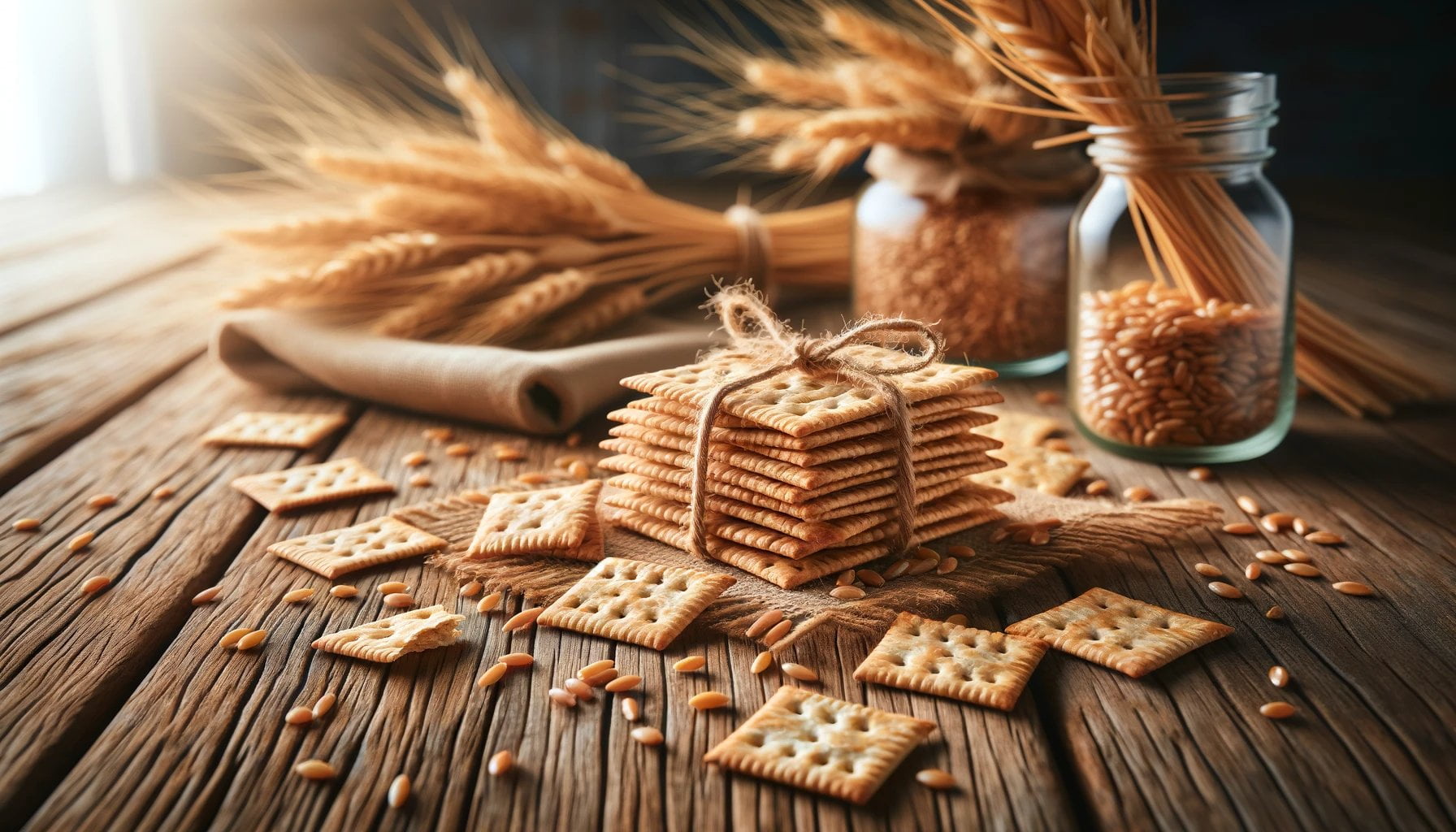Discovering the nutritional value of popular food items is essential in making informed decisions about our diets. In this article, we delve into the world of Wheat Thins, uncovering their nutrition facts to empower you in making healthier choices. With a keen focus on promoting overall well-being, we aim to provide you with accurate information to fuel your balanced lifestyle. Let’s explore the nutrition facts that lie within those crispy, flavorful Wheat Thins.

Key Takeaways:
- Wheat Thins contain a high amount of added sugar, with around five grams per serving, contributing to their potential downsides as a healthy snack option.
- The sodium content of Wheat Thins is around 200 mg per serving, which should be taken into consideration as excessive sodium intake can lead to health issues.
- Wheat Thins lack fiber and protein, making them less filling compared to other snack options.
- They are not a significant source of vitamins or minerals, primarily providing calories.
- To enhance the overall nutritional content, consider pairing Wheat Thins with protein sources like cheese or sliced meat, or fiber sources like sliced vegetables or fruit.
- While Wheat Thins can be enjoyed in moderation, it’s important to consider their high sugar and sodium content when making snacking choices and opt for alternative snacks that offer more nutritional value.
Nutrition Facts for Wheat Thins: Understanding the Truth Behind the Snack
When it comes to snacking, many people opt for Wheat Thins as a healthier alternative to potato chips or other salty snacks. However, before you indulge in these crispy delights, it’s crucial to understand their nutritional content and potential downsides. In this article, we will delve into the nutrition facts for Wheat Thins to empower you to make informed and healthy choices.
Digging into the Nutritional Content
Wheat Thins contain around five grams of sugar per serving, which is equivalent to 16 crackers or 31 grams. Surprisingly, 80% of this sugar is added sugar^1^. The ingredients list reveals the presence of a few varieties of sugar, including sugar, malt syrup, and refiner’s syrup. Considering that health authorities recommend limiting your daily intake of added sugar to no more than 10% of your daily calories, it’s essential to account for this high sugar content when making dietary decisions^1^.
Sodium content is another aspect worth considering. A single serving of Wheat Thins contains approximately 200 mg of sodium. Health authorities suggest limiting sodium intake to 2,300 mg per day. Consuming excessive sodium can contribute to high blood pressure and several other health issues^1^.
The Hunger Factor: Fiber and Protein Content
It is worth noting that Wheat Thins may not leave you feeling as satiated as other snack options, owing to their low fiber and protein content. While they are low in calories, they lack the fiber and protein that play crucial roles in creating a sense of fullness and satisfaction after eating^1^. As a result, you may find yourself craving more after consuming them.
Partnering for Better Nutrition
Although Wheat Thins are not a significant source of vitamins or minerals, they can be versatile in terms of how you enjoy them^1^. To improve the overall nutritional content of your snack, you can pair Wheat Thins with a protein source such as cheese, sliced meat, peanut butter, or fiber sources like sliced vegetables or fruit. This way, you can enhance the nutritional value and make your snacking experience more fulfilling.
The Bottom Line
While indulging in Wheat Thins in moderation can be enjoyable, it’s important to be mindful of their nutritional drawbacks. Their high sugar and sodium content, along with the lack of fiber and protein, should be factored into your decision-making process when it comes to snacking^1^. Considering alternative snack options that provide more nutritional value is always a wise choice in order to promote a balanced and healthy lifestyle.
Now that you are armed with all the nutrition facts for Wheat Thins, you can make empowered choices that align with your wellness goals. Remember, understanding the nutritional content of your favorite snacks is a vital step towards a balanced diet.
- Healthline – Are Wheat Thins Healthy? Nutrition, Benefits, and Downsides
- Eat This Much – Wheat Thins Nutrition Facts
Here is a list of active internal links with anchor text and URLs:
- Lipton hard iced tea nutrition facts: Curious about the nutritional content of Lipton hard iced tea? Check out the facts here!
- Rice Krispies treats nutrition facts: Discover the surprising nutritional information behind Rice Krispies treats!
- Diet ginger ale nutrition facts: Uncover the health benefits and facts about diet ginger ale here!
- Twisted tea half and half nutrition facts: Dive into the nutrition facts of Twisted Tea Half and Half, a refreshing beverage!
- Twisted tea rocket pop nutrition facts: Explore the nutritional details of Twisted Tea Rocket Pop and enjoy the nostalgia!
- Nutrition facts for spicy tuna roll: Hungry for some spicy tuna roll? Learn about its nutritional value here!
- Twisted tea light nutrition facts: Shed some light on the nutrition facts of Twisted Tea Light and make an informed choice!
- 20 oz Mtn Dew nutrition facts: Quench your thirst with 20 oz of Mtn Dew and find out its nutritional content!
- Nutrition facts for chicken fajitas: Get the lowdown on the nutrition facts of delicious chicken fajitas!
- Sour Patch Kids nutrition facts: Tackle your craving with Sour Patch Kids and learn about their surprising nutritional facts!
- Mountain Dew can nutrition facts: Crack open a Mountain Dew can and uncover its nutritional content!
- Cutwater lime margarita nutrition facts: Indulge in the flavors of Cutwater Lime Margarita while knowing its nutrition facts!
- High Noon tequila nutrition facts: Sip on High Noon tequila and discover its nutritional details!
- Nutrition facts of sirloin steak: Craving a juicy sirloin steak? Find out its nutritional facts here!
- Nutrition facts of Chips Ahoy: Love Chips Ahoy? Delve into their nutrition facts and enjoy the treat guilt-free!
- Ghost energy drink nutrition facts: Get a boost from Ghost energy drink while staying conscious of its nutritional value!
- Nutrition facts of Coca Cola: Dive into the nutritional facts of everyone’s favorite soda, Coca Cola!
- C4 energy drink nutrition facts: Unleash your energy levels with C4 energy drink and find out its nutritional content!
- Arnold Palmer spiked nutrition facts: Enjoy the Arnold Palmer spiked drink while knowing its nutritional facts!
- Nutrl vodka seltzer nutrition facts: Sip on Nutrl vodka seltzer and explore its impressive nutritional details!
- Can of Coke nutrition facts: Crack open a can of Coke and delve into its nutritional facts!
- Ben and Jerry nutrition facts: Indulge in your favorite Ben and Jerry ice cream while staying mindful of its nutritional content!
- Double Stuff Oreo nutrition facts: Discover the nutritional details behind the irresistible Double Stuff Oreos!
- Cayman Jack margarita nutrition facts: Treat yourself to a Cayman Jack margarita and be aware of its nutritional content!
Note: Markdown format requires the use of square brackets [] for anchor text and parentheses () for the URL.
Detailed Breakdown of the Calorie Content in Wheat Thins
Wheat Thins have become a popular choice for a quick and convenient snack. But have you ever wondered about the nutritional value of these crispy crackers? In this article, we will provide a detailed breakdown of the calorie content in Wheat Thins, empowering you to make healthier choices for a balanced lifestyle.
The Calorie Content of Wheat Thins
A serving of 16 Wheat Thins crackers, weighing approximately 31 grams, contains 140 calories[^1^]. This means that within these seemingly innocent and delicious crackers lies a moderate calorie load. It’s essential to understand the calorie content of the food we consume, as it directly affects our energy balance.
Fat, Carbohydrates, and Protein
Now, let’s take a closer look at the macronutrients in Wheat Thins. Each serving of 16 crackers contains 5 grams of fat, with only 0.5 grams being saturated fat[^1^]. This moderate fat content is relatively low compared to other processed snacks.
In terms of carbohydrates, a serving of Wheat Thins provides 22 grams[^1^]. Within this carbohydrate content, 3 grams come from dietary fiber, while 5 grams are from sugar[^1^]. It’s worth noting that Wheat Thins contain added sugars, though they are not considered a high-sugar snack[^2^]. Keep in mind that excessive sugar intake can have detrimental effects on our health, so it’s important to be mindful of our consumption.
When it comes to protein, Wheat Thins offer a modest 2 grams per serving[^1^]. This relatively low protein content may leave you feeling less satiated compared to options that offer higher protein levels. To enhance the overall nutritional value of your snack, consider pairing Wheat Thins with a protein source or fiber-rich foods.
Sodium and Potassium
Wheat Thins have a moderate sodium content, with each serving containing around 200 milligrams[^1^]. While this amount is not excessively high, it’s crucial to be mindful of sodium intake, especially if you have high blood pressure or other health conditions that require a limited sodium intake.
On the flip side, Wheat Thins provide 90 milligrams of potassium per serving[^1^]. Potassium is an essential mineral that plays a crucial role in various bodily functions, including nerve and muscle function. However, it’s important to note that the potassium content in Wheat Thins is not particularly high.
Whole Grains and Fiber
One of the key highlights of Wheat Thins is their use of 100% whole grain wheat. Whole grains provide essential nutrients and dietary fiber, which contribute to a balanced diet. Each serving of Wheat Thins offers around 3 grams of dietary fiber[^1^]. While this fiber content is not high, it still provides some benefits for digestion and overall health.
The Big Picture
Now that we’ve delved into the calorie content and nutritional breakdown of Wheat Thins, it’s important to consider the bigger picture. While Wheat Thins can be part of a balanced diet, it’s essential to be mindful of their high sodium and added sugar content, as well as their relatively low fiber and protein levels. Understanding the nutritional content of your favorite snacks empowers you to make informed decisions and keep your overall dietary balance in check.
Key Takeaways:
- A serving of 16 Wheat Thins crackers contains 140 calories.
- Wheat Thins have a moderate fat content, with 5 grams per serving.
- Each serving provides 22 grams of carbohydrates, including 3 grams of fiber and 5 grams of sugar.
- Wheat Thins offer a modest 2 grams of protein per serving.
- They contain around 200 milligrams of sodium and 90 milligrams of potassium per serving.
- Wheat Thins are made from whole grain wheat, providing around 3 grams of dietary fiber per serving.
- Being mindful of the high sodium and sugar content, as well as the low fiber and protein levels in Wheat Thins is important for making informed snacking choices.
Sources:
– Giant Food – Wheat Thins Crackers Original
– Healthline – Are Wheat Thins Healthy? Nutrition, Benefits, and Downsides
Exploration of the Fat, Carbohydrate, and Protein Content in Wheat Thins
Wheat Thins are a popular snack choice for many, but have you ever wondered about their nutritional content? In this article, we will delve into the fat, carbohydrate, and protein content of Wheat Thins and explore how they can fit into a healthy diet.
What Does the Nutrition Facts Table Say?
According to the nutrition facts table, a serving of Wheat Thins (16 crackers) contains 140 calories, 22 grams of carbs, 2 grams of protein, and 5 grams of fat[^1^]. While this may seem like a reasonable snack choice, it’s important to consider the bigger picture.
Understanding the Full Picture
Wheat Thins also contain high amounts of sugar and sodium, with around 5 grams of sugar and 200 mg of sodium per serving[^1^]. Additionally, they may not be as filling as other snack options due to their low fiber and protein content[^1^]. However, there are ways to enhance the nutritional value of Wheat Thins.
Enhancing the Nutritional Value
Pairing Wheat Thins with a protein source like cheese or sliced meat can boost their protein content and make them more satisfying[^1^]. You can also add fiber-rich foods, such as fruits or veggies, to your snack to increase its nutritional value[^1^]. It’s essential to be mindful of the high sugar and sodium content, as well as the lack of fiber and protein, when making snacking decisions.
Key Takeaways:
- Wheat Thins contain around five grams of added sugar per serving, equivalent to 16 crackers or 31 grams[^1^].
- Sodium content in Wheat Thins is approximately 200 mg per serving[^1^].
- Wheat Thins have a low fiber and protein content, which may not leave you feeling as satiated as other snack options[^1^].
- Pairing Wheat Thins with a protein source or fiber-rich foods can enhance the overall nutritional value[^1^].
- It’s important to be mindful of the high sugar and sodium content, as well as the lack of fiber and protein in Wheat Thins when making snacking decisions[^1^].
By understanding the nutritional content of your favorite snacks like Wheat Thins, you can make more informed choices for a balanced diet. Remember to incorporate a variety of nutrient-dense foods to ensure you’re getting all the essential nutrients your body needs.
[^1^]: Source: Healthline
Discussion on the Additional Nutrients and Health Benefits Offered by Wheat Thins
Are you curious about the nutritional value and health benefits of Wheat Thins? In this article, we will delve into the additional nutrients and advantages that this popular crispy wheat cracker brings to the table. Let’s explore the facts and empower you to make informed and balanced snacking choices.
Wheat Thins: A Crunchy Delight
Wheat Thins are well-known for their satisfying crunch and delicious taste. But what else do they offer? Let’s take a closer look at the additional nutrients and health benefits of Wheat Thins:
- Whole Grain Goodness: Wheat Thins are made from 100% whole grain wheat, providing you with the nutritional benefits of this valuable ingredient. Whole grains are rich in fiber, vitamins, minerals, and antioxidants, making them an essential part of a healthy diet.
- Dietary Fiber: Each serving of Wheat Thins contains around 3 grams of dietary fiber. Fiber plays a crucial role in maintaining digestive health, satiety, and controlling blood sugar levels. Incorporating fiber-rich foods like Wheat Thins into your diet can support a well-rounded nutritional lifestyle.
- Lower Fat Content: Wheat Thins are relatively low in fat, with only 5 grams per serving. This can be beneficial for individuals seeking to maintain or achieve a healthy weight. Remember, moderation is key when it comes to fat consumption.
- Versatile Snacking: Wheat Thins offer a versatile snacking option. They can be enjoyed on their own or paired with other nutritious ingredients, such as fruits, vegetables, or lean proteins. Adding complementary foods to your Wheat Thins snack can boost its overall nutritional value, making it a satisfying and wholesome option.
While discussing the additional nutrients and health benefits of Wheat Thins, it is important to consider a well-rounded perspective. It’s crucial to be mindful of certain factors, such as added sugar and sodium content, as well as the lack of fiber and protein compared to other snack options. This knowledge will enable you to make informed snacking decisions and maintain balance in your overall diet.
Key Takeaways:
- Wheat Thins are made from 100% whole grain wheat, offering the nutritional benefits of whole grains.
- Each serving of Wheat Thins provides approximately 3 grams of dietary fiber.
- Wheat Thins have a lower fat content compared to some other snack options.
- Pairing Wheat Thins with protein sources or fiber-rich foods can enhance their overall nutritional value.
- It’s important to be mindful of the high sugar and sodium content, as well as the low fiber and protein levels when consuming Wheat Thins.
- Incorporating Wheat Thins into a well-rounded and balanced diet can be a part of a healthy snacking routine.
Citation:
1. Healthline: Are Wheat Thins Healthy? Nutrition, Benefits, and Downsides
2. Livestrong: Are Wheat Thins Healthy?

FAQ
Q1: How many calories are in a serving of Wheat Thins?
A1: A serving of Wheat Thins (16 crackers or 31 grams) contains 140 calories.
Q2: How much sugar is in Wheat Thins?
A2: Wheat Thins contain around 5 grams of sugar per serving, of which 80% is added sugar.
Q3: Are Wheat Thins a good source of fiber?
A3: Wheat Thins have a low fiber content and do not provide a significant amount of dietary fiber.
Q4: Can Wheat Thins be a good snack option for weight loss?
A4: While Wheat Thins are low in calories, they may not be as filling due to their low fiber and protein content. It is important to consider them in the context of a well-rounded diet for weight loss.
Q5: Are Wheat Thins gluten-free?
A5: No, Wheat Thins are not gluten-free. They are made from whole grain wheat.
- Crypto Quotes’ Red Flags: Avoid Costly Mistakes - June 30, 2025
- Unlock Inspirational Crypto Quotes: Future Predictions - June 30, 2025
- Famous Bitcoin Quotes: A Deep Dive into Crypto’s History - June 30, 2025
















